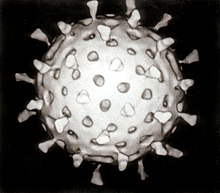Virus (biołozia)
El virus (dal latin vīrus, "velen") el xe un'entità bioloxega co carateristeghe de parasita obligato, in cuanto se replica esclusivamente al'interno de le celule dei organismi. I virus i poe infetare tute le forme de vida, dai animali, ale piante, ai microrganismi (conprexi altri axenti infetanti come i bateri) e anca altri virus.[1][2]
| Virus | |
|---|---|
 | |
| Classificazione scientifica | |
| Dominio | Acytota |
| Gruppi I-VII | |
| |
| Proprietà | Parametri |
|---|---|
| Asido nucleico |
|
| Forma |
|
| Caene |
|
| Senso |
|
Tasonomia
canbiaL'International Committee on Taxonomy of Viruses (ICTV) el ga sviluppà l'atuale sistema de clasificasion e ga formulà le ligne guida che atribuise un pexo majore a calche proprietà virale par mantegnere l'uniformità de la fameja. La xe stà istituia na tasonomia unificada:
Bibliografia
canbia- (EN) Leslie Collier, Albert Balows e Max Sussman, Virology, in Brian H Mahy e Leslie Collier (a cura di), Topley and Wilson's Microbiology and Microbial Infections, vol. 1, 9ª ed., Arnold, 1998, ISBN 0-340-66316-2. accesso richiede url (aiuto)
- (EN) Nigel J. Dimmock, Andrew J. Easton e Keith N. Leppard, Introduction to Modern Virology, VI, Blackwell Publishing, 2007, ISBN 1444308920.
- (EN) Knipe, David M; Howley, Peter M; Griffin, Diane E; Lamb, Robert A; Martin, Malcolm A; Roizman, Bernard; Straus Stephen E. (2007) Fields Virology, Lippincott Williams & Wilkins. ISBN 0-7817-6060-7.
- (EN) Teri Shors, Understanding Viruses, Jones and Bartlett Publishers, 2008, ISBN 0-7637-2932-9.
- (EN) S. Casjens, Assembly of Bacterial Viruses, in Brian W. J. Mahy e Marc H. V. Van Regenmortel (a cura di), Desk Encyclopedia of General Virology, Boston, Academic Press, 2010, pp. 167–174, ISBN 0123751624.
- (EN) F. Fenner, History of Virology: Vertebrate Viruses, in Brian W.J. Mahy e Marc H.V. Van Regenmortel (a cura di), Desk Encyclopedia of General Virology, 1ª ed., Oxford, UK, Academic Press, 2009, pp. 15–19, ISBN 0-12-375146-2.
- (EN) P. Forterre, Origin of Viruses, in Brian W.J. Mahy e Marc H.V. Van Regenmortel (a cura di), Desk Encyclopedia of General Virology, Oxford, Academic Press, 2009, pp. 23 ..., ISBN 0-12-375146-2.
- (EN) Belay ED and Schonberger LB, Desk Encyclopedia of Human and Medical Virology, Boston, Academic Press, 2009, pp. 497–504, ISBN 0-12-375147-0.
- (EN) John Carter e Venetia A. Saunders, Virology: principles and applications, Chichester, John Wiley & Sons, 2007, ISBN 9780470023860.
- (EN) Jaap Goudsmit, Viral Sex: The Nature of AIDS, Oxford Univ Press, 1998, ISBN 0-470-02387-2.
- (EN) Dorothy H. Crawford, Viruses: A Very Short Introduction, Oxford University Press, 2011, ISBN 0-19-957485-5.
- (EN) King AMQ, Lefkowitz E, Adams MJ, Carstens EB, Virus Taxonomy: Ninth Report of the International Committee on Taxonomy of Viruses, Elsevier, 2011, p. 6, ISBN 0-12-384684-6.
- (EN) Fisher, Bruce; Harvey, Richard P.; Champe, Pamela C., Lippincott's Illustrated Reviews: Microbiology (Lippincott's Illustrated Reviews Series), Hagerstwon, MD, Lippincott Williams & Wilkins, 2007, pp. pages 367–392, ISBN 0-7817-8215-5.
- (EN) Bruce Alberts, Alexander Johnson, Julian Lewis, Martin Raff, Keith Roberts, and Peter Walters, Molecular Biology of the Cell; Fourth Edition, New York and London, Garland Science, 2002, ISBN 0-8153-3218-1. URL consultato il 19 dicembre 2014.
- (EN) George P. Lomonossoff, Virus Particles and the Uses of Such Particles in Bio- and Nanotechnology, in Recent Advances in Plant Virology, Caister Academic Press, 2011, ISBN 978-1-904455-75-2.
- (EN) Gleba, YY; Giritch, A, Plant Viral Vectors for Protein Expression, in Recent Advances in Plant Virology, Caister Academic Press, 2011, ISBN 978-1-904455-75-2.
- (EN) Witzany G (Ed), Viruses: Essential Agents of Life, Springer, 2012, ISBN 978-94-007-4898-9.
Nòte
canbia- ↑ Bernard La Scola, The virophage as a unique parasite of the giant mimivirus.
- ↑ (EN) Ed Yong, The virophage – a virus that infects other virusesphenomena.nationalgeographic.com, 8 luglio 2008. entrada il 12 marzo 2016.

